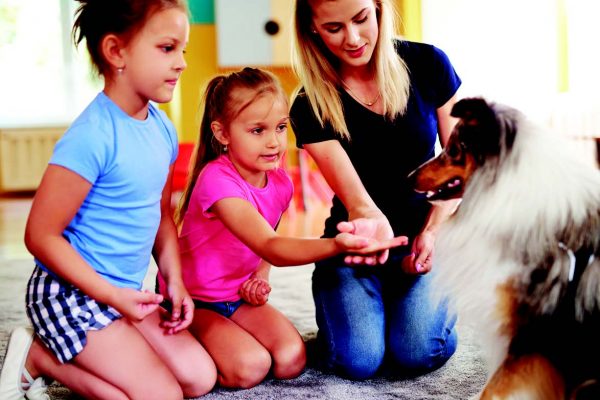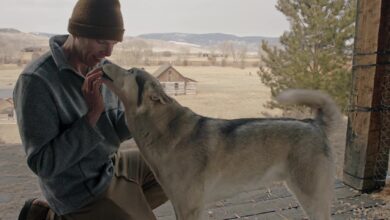How to Prevent Dog Bites in Children And What to Do if Your Dog Bites Your Kid

“Vector bit me!” cried my toddler, Nicholas. Unconvinced, given Nicholas’ active imagination, I rose to investigate. I found myself arbitrating between one party — my beloved son, frequently incapable of telling the truth, and another — my beloved rescue dog, inherently incapable of telling me anything. At first glance, no clues.
But for once my toddler wasn’t exaggerating. Evidenced by the pink tears streaming down his face, Vector had bit-ten him right on the cheek, fiercely enough to draw blood. Nicholas was screaming, and I was … stunned.
To say this was uncharacteristic of Vector would be an understatement akin to shrugging nonchalantly as Lassie devoured Timmy (of the 1954 Lassie TV series). At 9 years old, Vector had never displayed aggression toward people — especially not his immediate family — and his time with us predated Nicholas’ existence. Since becoming a four-legged big brother in 2016, Vector had taken the standard whacks, shoves, yanks and tumbles to which small children subject their dogs with diplomatic indifference.
Vector loved Nicholas and vice versa. So what, exactly, had happened?
Behind the bite
Separating the biter from the bitten, I took Vector to an adja-cent room, closing the door behind me. Next came Nicholas. Suspecting a toddler’s selective memory would soon distort facts with fictions, I handed him a stuffed animal. “Show me what happened,” I said. Nicholas reenacted one of his signa-ture moves: hugging Vector from behind. Though ill-advised in hindsight, it’s a scenario that had played out hundreds of times before. Why had this instance ended in bloodshed?
I went back to Vector. After a few choice words that, looking back, I’m grateful he couldn’t fully comprehend, I calmed down, turned him around and replicated Nicholas’ approach. Nothing.
I was, I knew, Vector’s favorite person. If I could get him to react to me, it would confirm my suspicion that the bite was a defensive response to pain. I tried again, this time pressing under his right haunch. Yipping, Vector nipped at the air near my hand — about as close as he’d ever get to biting me. Bingo.
The next day, a trip to the vet revealed a recently received bruise, likely accrued from high jinks during one of Vector’s infamous attempts at food thievery. Case closed, but the last thing I wanted was a repeat offense. Here’s what I’ve learned about preventing dog bite incidents around children.
Supervise, supervise, supervise
My family’s bite incident — one involving an intimately bonded dog and a child he’d lived with and loved for three-plus years — showcases the ease with which comfort can breed complacency. I was guilty of overly trusting a ram-bunctious 3-year-old and an eminently huggable pet who, despite being typically tolerant, still has the capacity to act out if startled, threatened or nursing an injury.
I should have been practicing the same precautions with Nicholas that would mitigate the likelihood of Vector biting any small child, whether mine or a perfect stranger’s. While beautiful together, young kids and dogs can create a volatile situation that demands proper oversight.
“The first thing I tell adopters is to always supervise your kids with your dog at all times,” says Samantha Gurrie, director of adoptions for Brooklyn-based The Sato Project, which rescues dogs from Puerto Rico and places them with families throughout the Eastern United States.
Of course, Samantha recognizes the near-impossibility of monitoring both our children and dogs at all times. In instances where, for example, an adult is running around the house tending to chores — or, increasingly the case for many, working from home — it’s time to contain the dog away from the child. Here, pet or baby gates can be effective tools, as they generally allow the dog to still see everything and therefore not feel entirely walled off.
Teach kids dog do’s and don’ts
Samantha also emphasizes the importance of teaching small children who live with dogs how to properly interact with them.
“Don’t bother a dog when he’s sleeping, don’t grab ears or pull tails, don’t jump on top of him,” Samantha continues. “I’ve cringed seeing social media photos of kids crawling all over dogs or even riding them like horses.”
She adds that small children, lacking impulse control and the ability to comprehend that dogs may misconstrue innocent intentions, are almost always the instigator in a bite incident. Grabbing a toy or treat the dog is enjoying, bothering him during mealtime and naptime or otherwise surprising the animal, all bring potential for an interspecies encounter to go astray.
According to Jill Breitner, canine body language expert and founder of California-based Shewhisperer Dog Training, 77% of dog bites happen to friends and family. For families struggling with canine-child compatibility, she recommends contacting Family Paws Parent Education, which offers safety programs.
Be aware of Body Language
Of course, bite prevention practices also must extend beyond the home. Adults with dogs must remember that kids will be … well, kids. Unpredictable, unknowing, vulnerable kids. The impetus is on grown-ups to identify signs of canine wariness that could be a harbinger of a nip, bite or other outburst.
“It’s important to know the warning signs that a dog is stressed: looking away, hiding, lip licking, panting, drooling,” Jill says.
Prevent problem situations
Situational awareness is another priority. Surprise, surprise: Family dogs home in on human food. So particular caution must be taken during gatherings involving food — especially large ones such as backyard BBQs. For cunning canines who, like Vector, are adept at food thievery, a munching kid is the easiest of marks and, should the child overreact, the encounter could entail more than a burger being bitten. Considering this, leashing (if outside) or removing your dog from the room (if inside) during food-centric gatherings is the safest way to go.
There is also one glaring outside-the-home don’t: Never tether your dog and walk away. Like humans, dogs have two options when threatened: fight or flight. Tying your pet to a pole while you run in for coffee takes away the preferred option — flight — and exponentially increases the likelihood of the other. Don’t give a small child — or anyone else — the opportunity to approach your cuddly yet captive pet, because a gentle pat on the head could become a not-so-gentle bite on the hand.
Unfortunately, no prevention method is completely foolproof. If a dog bite does occur, Samantha and Jill agree that reprimanding the dog, which at first might seem logical, is in fact counterproductive. Per Jill, “Verbally or physically punishing dogs only adds to their fear, which in turn escalates the chance of another bite.”
With vigilance and best practices, the risk of dog bite incidents with small children shrinks significantly. As for my family, one bite does not a relationship ruin: Nicholas, though once bitten, is by no means shy about embracing his four-legged big brother … except now, he’s sure to approach from the front.
Read Next: How to Help Your Dog Through Big Changes
Why Gates Are GREAT!
When you can’t monitor small kids and dogs, manage the situation by using a gate. They keep children and dogs separated but allow the dogs to see what’s going on and feel part of the family.


Source link






